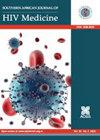HIV testing at birth: Are we getting it right?
IF 1.6
4区 医学
Q4 INFECTIOUS DISEASES
引用次数: 9
Abstract
Background Birth polymerase chain reaction (PCR) testing improves early detection of HIV and allows for early treatment initiation. National guidelines exist, but it is unknown whether these are being implemented correctly. Objectives To determine whether HIV-exposed infants at the Mangaung University Community Partnership Programme Community Health Centre (MUCPP CHC) received PCR tests at birth, if HIV-positive infants were initiated on treatment, if follow-up dates were scheduled and the percentage of mothers or caregivers who returned to collect the results. Methods The study was a retrospective descriptive file audit (1304 files) of births from 01 January to 31 December 2016 at MUCPP CHC. The study sample was 428 infants born to HIV-positive mothers. The birth register was used to collect the infants’ HIV PCR test barcodes. The birth and 10-week PCR results were retrieved from an electronic database at the Virology Department, University of the Free State. Results In total, 375 infants received a birth PCR test (87.6%) of which 4 (1.1%) tested HIV positive and 327 (87.2%) negative. Follow-up tests were not scheduled. However, 145 (44.3%) HIV-negative infants returned for a 10-week test. Irrespective of the PCR birth result, 157 (36.7%) infants were brought for a 10-week follow-up test at which time 3 (1.9%) tested positive and 151 (96.2%) negative. Conclusion The majority of HIV-exposed infants received a PCR test at birth; however, the clinic is below the national target (90%) for HIV testing. A record-keeping system of infants’ visits does not exist at MUCPP CHC, making it impossible to determine whether HIV-positive infants were started on antiretroviral treatment.出生时的艾滋病毒检测:我们做对了吗?
出生聚合酶链反应(PCR)检测提高了艾滋病毒的早期发现,并允许早期开始治疗。国家指南是存在的,但不知道这些指南是否得到了正确的执行。目的确定在mangung大学社区伙伴计划社区卫生中心(MUCPP CHC)的艾滋病毒暴露婴儿是否在出生时接受了PCR检测,艾滋病毒阳性婴儿是否开始接受治疗,是否安排了随访日期以及返回收集结果的母亲或照顾者的百分比。方法对2016年1月1日至12月31日在MUCPP CHC出生的1304个文件进行回顾性描述性文件审核。研究样本是428名艾滋病毒阳性母亲所生的婴儿。利用出生登记簿收集婴儿HIV PCR检测条形码。出生和10周PCR结果从自由邦大学病毒学系的电子数据库中检索。结果375例(87.6%)新生儿接受出生PCR检测,其中HIV阳性4例(1.1%),阴性327例(87.2%)。后续测试没有安排。然而,145名(44.3%)艾滋病毒阴性婴儿返回进行为期10周的检测。无论PCR出生结果如何,157名(36.7%)婴儿接受了为期10周的随访检测,其中3名(1.9%)检测呈阳性,151名(96.2%)呈阴性。结论大多数hiv暴露婴儿在出生时接受PCR检测;然而,该诊所的艾滋病毒检测率低于国家目标(90%)。MUCPP CHC没有婴儿就诊记录系统,因此无法确定艾滋病毒阳性婴儿是否开始接受抗逆转录病毒治疗。
本文章由计算机程序翻译,如有差异,请以英文原文为准。
求助全文
约1分钟内获得全文
求助全文
来源期刊
CiteScore
2.80
自引率
11.80%
发文量
41
审稿时长
>12 weeks
期刊介绍:
The Southern African Journal of HIV Medicine is focused on HIV/AIDS treatment, prevention and related topics relevant to clinical and public health practice. The purpose of the journal is to disseminate original research results and to support high-level learning related to HIV Medicine. It publishes original research articles, editorials, case reports/case series, reviews of state-of-the-art clinical practice, and correspondence.

 求助内容:
求助内容: 应助结果提醒方式:
应助结果提醒方式:


